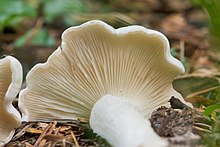White tuft rasp
| White tuft rasp | ||||||||||||
|---|---|---|---|---|---|---|---|---|---|---|---|---|

White clump rasp ( Leucocybe connata ) |
||||||||||||
| Systematics | ||||||||||||
|
||||||||||||
| Scientific name | ||||||||||||
| Leucocybe connata | ||||||||||||
| ( Schumach .: Fr. ) Vizzini , P. Alvarado , G. Moreno & Consiglio |
The White Büschelrasling , White Rasling or Corydalis Ritterlingsartige ( Leucocybe connata , Syn. Clitocybe connata , Lyophyllum connatum ) may from August to October tufted or in small groups on freshly dug Erdstellen, lawn, stream edges, as well as travel and roadsides be found.
In older mushroom literature it is shown as edible, but more recent findings show that some of the ingredients of this mushroom are present in high quantities and therefore can probably have a mutagenic effect.
features
Macroscopic features
The 3 to 10 centimeters wide, initially bell-shaped and later arched to spread out hat has a pure white color when dry and shows a lead-gray tone in damp weather. The surface is frosted silver-gray to opaque white. After wiping off the hoop, dirty-gray stains appear, which can also appear on the lamellas, on the handle and in the tram. The brim of the hat is thin, curved when young, then flat and wavy. The lamellae are whitish, later cream-colored, a little yellowish with age, often with a sea-green shade. They are densely packed, have bulging or bulging on the stem and rarely run down a little. The spore powder is white. The 4 to 10 centimeter long and 1 to 2 centimeter thick stem is white to creamy yellow in color. Except for the slightly floury-flaky tip, it has a bare surface. Initially full-bodied, the stem is later almost hollow and somewhat puffed up. The fruiting bodies are grown together in tufts at the base, branch out partially above the ground, but can also stand individually. The white, slightly glassy meat has a gristly consistency and tastes mild. The slightly flour-like, spiritual smell is overlaid by a sweet scent of lark's spur blossoms ( Corydalis cava ).
The macrochemical color reaction with iron sulphate is a good determinant : If FeSO 4 in crystal form or as a solution is rubbed or dabbed on the lamellas, the meat turns purple. Other funnels , however, have a negative color reaction.
Microscopic features
Elliptical, smooth-walled spores mature on the only young siderophilic basidia . They are 5.5 to 6.5 at most 7 micrometers long and 3.5 to 4 micrometers wide.
ecology
The white tussock lives saprobic and is therefore not dependent on any particular forest or forest society. The fungus occurs both in and outside of closed tree communities, for example in parks and gardens, on the edges of forests, clearings and hedges, in bushes, on the edges of graveled forest paths and streams, on heaps, fat meadows and pastures. The species prefers fresh to moist, neutral to alkaline as well as base and nutrient-rich soils with lime and / or nitrogen compounds (manure, urine, liquid manure, slurry and others). The topsoil can be bare or enriched with sawdust and other organic material. They are located above diverse, as strongly alkaline weathering as possible parent rock. The fungus fructifies in Central Europe mainly from August to November.
distribution
The occurrence of the white tufted rasp extends to the temperate to cold temperate latitudes of the northern hemisphere . In North Asia, finds from Japan, the Caucasus and Siberia are known. The species is widespread on the European continent: in the southeast it grows in Italy, Moldova, Romania and the Ukraine. In the west, the mushroom can be found in the Benelux countries, France and the UK. In the middle it is native to Germany, Liechtenstein, Austria, Poland, Switzerland, Slovakia, the Czech Republic and Hungary. Finds from the Baltic States , Russia and Belarus are reported from the east and north-east . In the north of Europe the white tussock rasp can be found in Fennoscandinavia , in Finland the occurrence extends northwards up to the 68th parallel. The species is also found in Iceland. In Germany the species is fairly even and widespread from the Danish border to the Alps.
swell
literature
- Lutz Roth, Hanns Frank, Kurt Kormann: Poisonous mushrooms, mushroom poisons. Molds - Mycotoxins - Occurrence - Ingredients - Fungal allergies - Food poisoning . Reprint of the 1989 edition. 1st edition. Nikol, Hamburg 1990, ISBN 3-933203-42-2 , pp. 88 .
Individual evidence
- ↑ Pablo Alvarado, Gabriel M. Horcajada, Alfredo Vizzini, Giovanni Consiglio, Jose L. Manjón, Ledo Setti: Atractosporocybe, Leucocybe and Rhizocybe, three new clitocyboid genera in the Tricholomatoid clade (Agaricales) with notes on Clitocybe and Lepista . In: Mycologia . tape 107 , no. 1 , 2015, p. 123-136 , doi : 10.3852 / 13-369 , PMID 25344261 .
- ↑ Henning Knudsen, Jan Vesterholt: Funga Nordica. Agaricoid, boletoid, clavarioid, cyphelloid and gastroid genera . 2nd Edition. Nordsvamp, Copenhagen 2012, ISBN 978-87-983961-3-0 , p. 453–454 (English, revision of Nordic Macromycetes Volume 2).
- ↑ Klaus Roth: Chemist-style mushroom ragout. Maître Steglich and his kitchen brigade cook . In: Chemistry in Our Time . tape 49 , no. 3 , June 2015, p. 196–212 , doi : 10.1002 / ciuz.201500712 .
- ↑ a b c German Josef Krieglsteiner (ed.), Andreas Gminder : Die Großpilze Baden-Württemberg . Volume 3: Mushrooms. Blattpilze I. Ulmer, Stuttgart 2001, ISBN 3-8001-3536-1 , pp. 305-306.
- ↑ Erhard Ludwig: Descriptions. The smaller genera of macromycetes with a lamellar hymenophore from the orders Agaricales, Boletales and Polyporales . In: Mushroom Compendium . tape 1 . IHW, Eching 2001, ISBN 3-930167-43-3 , p. 299-300 .
Web links
- Frank Moser: Species portrait: White Rasling ( Lyophyllum connatum ) . On: Natur-Lexikon.com . Retrieved April 23, 2011.
- Georg Müller: Photos of Lyophyllum connatum . In: picture gallery on pilzepilze.de . Retrieved April 23, 2011.
